Edward P FreelandLecturer and Executive Director of the Data Driven Social Science Initiative at Princeton University.
The gradual decline of trust in government has been a major theme in American public opinion research for some fifty years now. This decline can be seen not only in the declining confidence citizens express in the federal government, but also in major American institutions and organizations such as journalism, the media, medicine and big business. The decline in trust in government is not limited to the United States. It is a phenomenon observed in many consolidated democracies around the world.
The Pew Research Center graph shows the long-term decline in public confidence in government, based on a moving average calculated from the many polls conducted over this period. While it peaked at around 75% in the 1960s, it gradually eroded, reaching 40% in the early 1980s, then fluctuating for a while, and stagnating below 30% since the Great Recession of 2008.

How is the decline in trust in government government a problem for democracy?
This downward trend raises the question of the limit at which the federal government will no longer be able to function due to an excessive lack of trust. Distrust reduces support for government action and the search for partisan compromise on public policy, making it more difficult to solve major political and social problems. Declining trust is also linked to increasing political polarization. In the two-party system, the problem is exacerbated: when one party becomes more defiant and less willing to negotiate with the other, the question of the quality of democracy immediately arises.
Faced with this dysfunction, it is possible that individuals more open to political alternatives that are seen as more effective than than representative democracy, such as authoritarian or military rule. or military rule. Using data from the World Values Survey data from the World Values Survey, that this shift is already underway.
It should be stressed that individuals' perception of government effectiveness is strongly influenced by partisan bias. If we were to isolate in the previous graph respondents who support Democrats and those who support Republicans, we would see that confidence also depends on the party in power: Republican supporters are more confident when Republicans govern, and vice versa. But while it explains some of the fluctuations, partisan bias does not account for the secular decline in confidence in the federal government.
So why is this happening? ? A first set of explanations points to the role of cultural factors: the general general decline in social capital has led to greater individual isolation of individuals, and government is perceived to be further removed from the people's daily lives. Another set of explanations concerns theeffectiveness attributed to government. government: it may simply be that the decline in trust is associated with a the perception of a government that is not working as well as in the problems that affect citizens on a daily basis.
Another example is the impact of political campaigns and the use of political advertising, which has intensified and become more negative in elections in recent decades. It is now common for politicians to get elected by portraying their opponents in a negative light. This has most likely had a negative impact on our entire political system and its representation in the electorate. The decline in confidence in government has occurred at the same time as the increase in political polarization. We know, for example, that people are less willing to live with or marry people from the other political party. As trust diminishes, so does the willingness of each party to cooperate with the other.
We must also question the validity we measure when we ask questions about trust in government. trust in government. For example, a question on theAmerican National Election Survey (ANES) asks whether the government succeeds in "doing the right thing". to "do the right thing". Researchers have also asked whether trust trust and distrust are two ends of the same continuum, or whether they are two different concepts. In fact, by measuring the presence or absence or absence of trust, many studies have overlooked what might lie in between.
Breaking down the different dimensions of trust in government
To bring some clarity to the debate, our survey breaks down trust into its constituent dimensions. We can thus observe which of these dimensions matter most to citizens, and to what extent they correlate with trust in general. A similar initiative was recently launched by the OECD.
The four dimensions of trust to which we have turned our attention are as follows.
- Is itappropriate for government to intervene in a particular area of public action (i.e., should it try to solve problems in that area?)?
- Secondly, to what extent do people feel that the government istransparent about what it does?
- Thirdly, does the government have the resources andexpertise it needs to carry out its work in this particular sector?
- Fourth, is the governmentreliable in the work it does?
We have applied this grid to five different major areas of public intervention:
- bank regulation,
- protecting people from COVID-19,
- immigration control,
- environmental protection,
- maintaining military forces.
Concretely, we measured the degree of agreement with each dimension and for each area of intervention in the form of a scale ranging from 1 for "strongly disagree" to 7 for "strongly agree". Finally, we added a more global question on confidence in the federal government's action in each of the five areas of public intervention.
For example, people were asked in turn about the desirability of the federal government regulating the banking sector; whether the government is clear and transparent about how it regulates banks; whether the government has the expertise and resources to regulate banks; and whether it is trustworthy when it comes to regulating banks. Finally, a fifth question asked about overalltrust in the federal government's regulation of banks.
We also included an experiment, with a general question from the Gallup Institute: " How much do you trust our federal government in Washington when it comes to dealing with national issues?". Half the sample was randomly selected to answer this question at the very beginning of the survey. The other half was presented with the same question, but this time towards the end of the questionnaire, after the questions on areas of intervention. We felt that if respondents first thought in more detail about what the federal government does, then they would give more informed, and therefore potentially different, answers to the general question about trust.
Our survey was conducted with the CINT American panel between April 1 and 7, 2022. We obtained 1,022 responses. To make the results representative, the sample was then adjusted according to standard socio-demographic and geographic criteria, derived from the 2015-19American Community Survey estimates and the 2020 presidential election result.
Relevance and expertise of government intervention widely supported
The results presented below correspond to the average agreement and disagreement scores (Figures 2 to 6). It's worth noting that for all five areas tested, we observe a similar trend: the relevance of government intervention and its expertise are rated significantly higher than its transparency and reliability.
We can also see that overall trust in each policy area is closely linked to the criteria of reliability and transparency. For example, when asked about the federal government's handling of the COVID-19 pandemic, respondents said it was important for the government to engage with the issue, and that it had both the expertise and resources to do so. Here too, transparency and reliability received lower marks, as did overall confidence in the government's response to COVID-19. We observe the same response logic for immigration control, environmental protection and the military, which until recently was one of the most trusted institutions in the US.
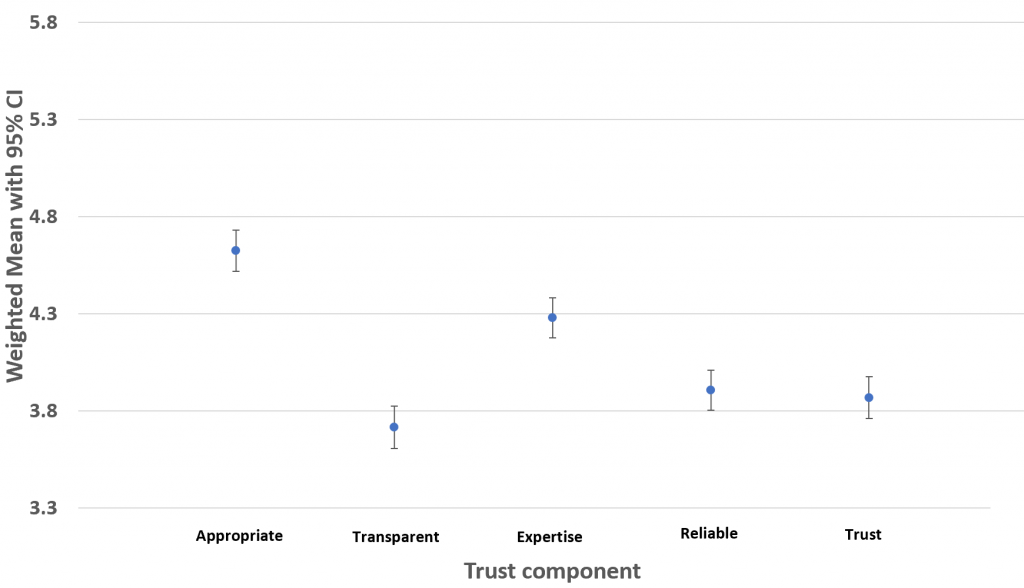
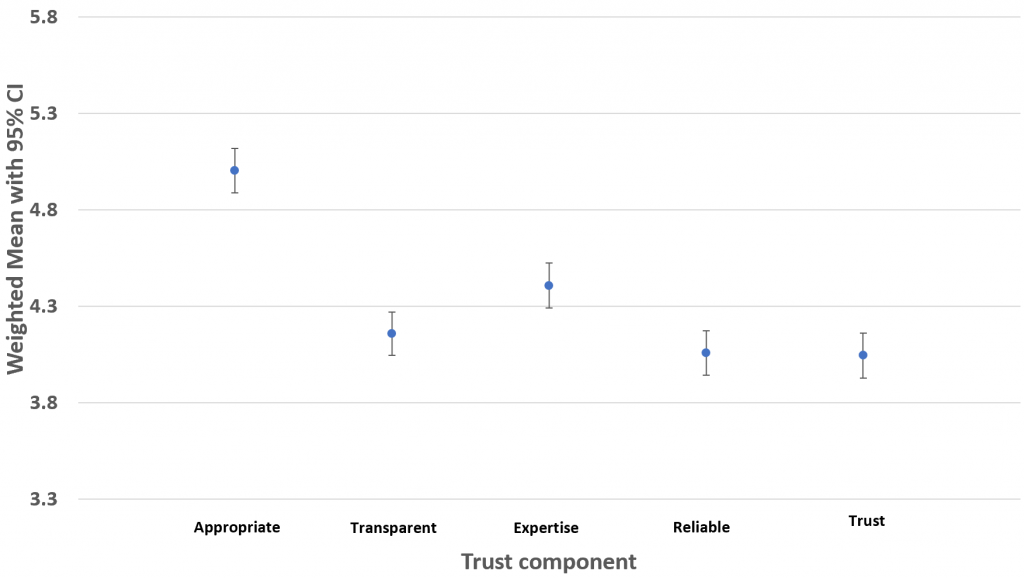
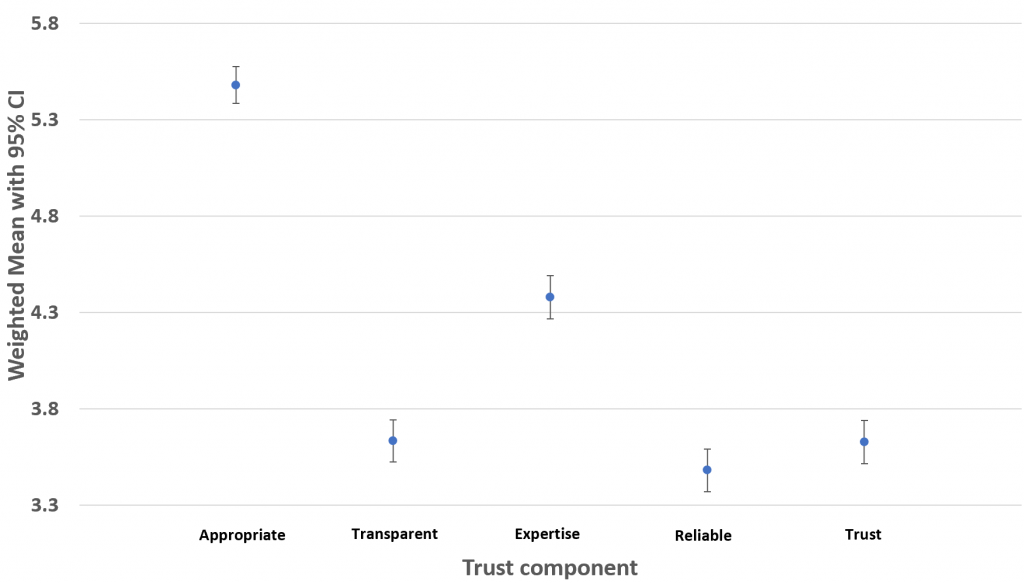
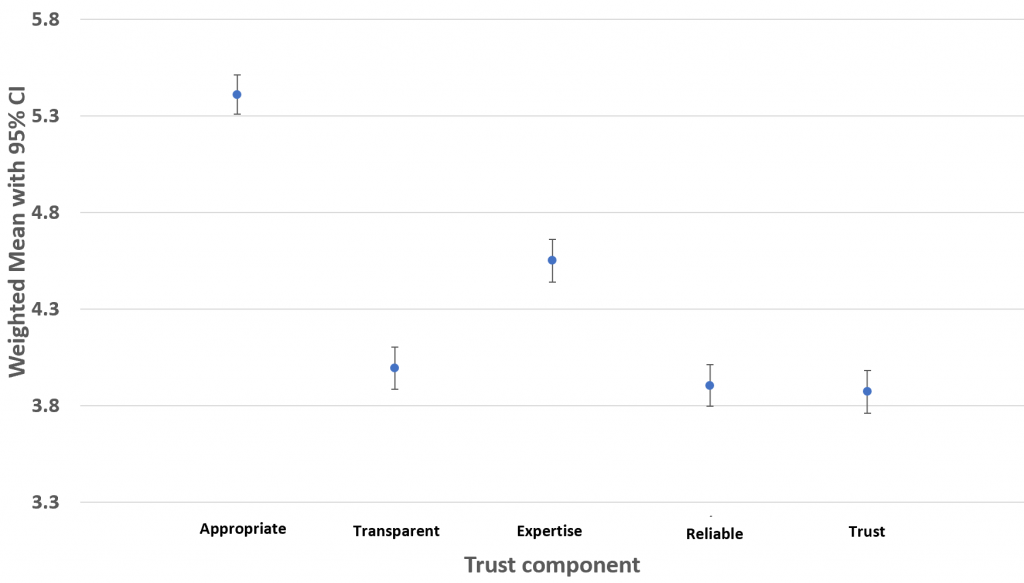
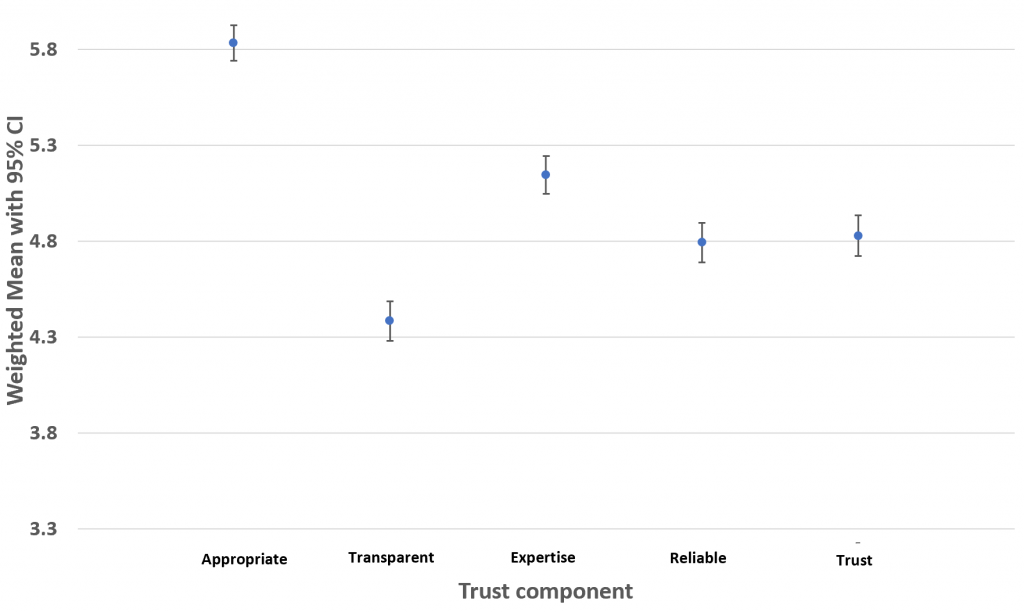
What about experimentation? Our hypothesis was that, after examining and reflecting in detail on what the government does, people who were asked to answer a question about confidence in the federal government at the end of the survey might turn out to be more confident than those who were asked the same question at the beginning. While this was indeed the case, the difference was not statistically significant.
In conclusion, we find that overall trust depends to a large extent on evaluations of the transparency and reliability of public action. While many respondents recognize the relevance of government intervention and its expertise in the five major areas of public action examined, the federal government is much less likely to be seen as transparent and reliable when it comes to achieving results. These two factors are closely linked to lower levels of general trust. Nor did we identify the existence of any domain-specific effect that might, for example, have penalized overall trust in the federal government.
More transparency?
These results suggest that people are not ready to abandon democracy for an alternative system of government. Faced with the crisis of confidence in public institutions, one way forward would therefore be to better understand how government can be more transparent about what it does, and whether it is really effective in setting its agenda as well as in applying regulations to specific policies.
Some would argue that the government is to a large extent already transparent, spending billions of dollars on independent evaluations of its impact and effectiveness. Agencies such as theOffice of Management and Budget (OMB) and the General Accounting Office (GAO) produce numerous reports and evaluations of government programs. While these reports are intended for members of Congress as well as the general public, it's not clear that the average citizen really grasps them. Ironically, the decline in trust in government has occurred at the same time as the documentation, reporting, accounting and independent evaluation of government agencies have increased dramatically, contrary to public opinion.
Is increasing government transparency a solution? Research shows that greater openness and transparency increase trust in government, but only up to a point. Beyond that, too much transparency can undermine trust. There is another important distinction between transparency designed to comply with legal requirements, and transparency designed to address the concerns of ordinary citizens. Given that much of what governments do in the way of transparency is about complying with laws, a next step in our research could be to identify the kind of information the general public needs to better understand what their government is doing, and to what extent this information is likely to slow or even reverse the decline in trust in government.
Is increasing government transparency a solution? Research shows that greater openness and transparency increase trust in government, but only up to a point. Beyond that, too much transparency can undermine trust. There is another important distinction between transparency designed to comply with legal requirements, and transparency designed to address the concerns of ordinary citizens. Given that much of what governments do in the way of transparency is about complying with laws, a next step in our research could be to identify the kind of information the general public needs to better understand what their government is doing, and to what extent this information is likely to slow or even reverse the decline in trust in government.
The author would like to thank Frédéric Gonthier and Tristan Guerra for their editorial suggestions, and Naila Rahman, Rachael Johnson, Brian Lee and Osama Safeer for their help in designing the questionnaire.